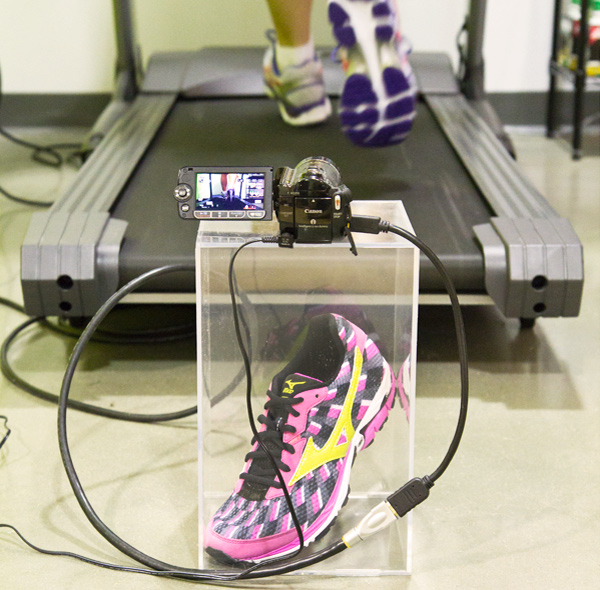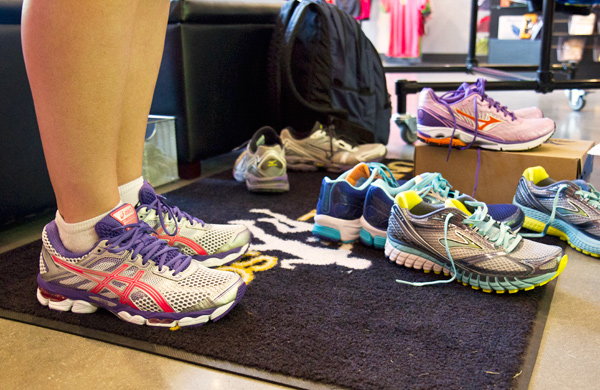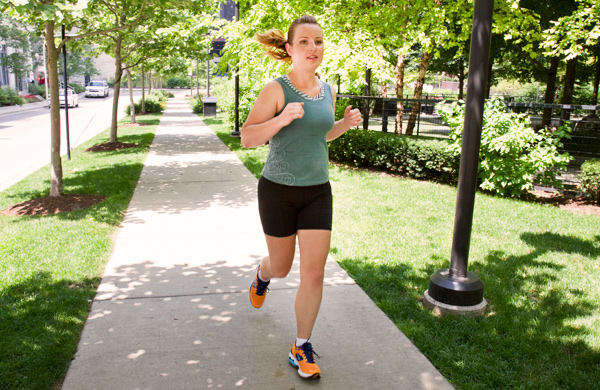
"Are you training for anything right now?"
In any other context, this sentence might have been considered small talk. But I had just walked into
Universal Sole, a specialty running store in downtown Chicago, where such a detail could turn out to be crucial in choosing your perfect running shoe. Asking the question was Universal Sole event coordinator and five-year retail veteran Ryan Dolan, who represents one of the best reasons to visit a specialty running store over a standard shoe store: the staff can typically assess dozens of physical factors to determine which shoe is right for you.

Ryan has other ways to evaluate a runner besides asking questions, particularly when it comes to your gait—the unique way in which your foot strikes the ground. Among the brightly colored running shoes, stylish athletic apparel, and novel training accessories sits a treadmill, which Ryan uses to analyze each customer's running style. Before I got my turn, Ryan fitted me with a shoe that was pretty close to the ones I owned, making sure the sole was flexible so the shoe wouldn't hide any oddities in my running pattern. I hopped onto the treadmill, he turned on a video camera behind me, and I started to run.
 The Three Stages of a Step
The Three Stages of a Step
When I finished, we both watched the recording, slowed down to 1/8 speed. This was new to me—I've run on shoe-store treadmills in the past but have always been at the mercy of the expert's analysis, which was sometimes difficult to understand. When I watched myself run, Ryan's words made sense, since I could see the angle and position of my feet on screen.

As we watched, he divided my foot strike into three stages. The first stage, when the foot touches the ground, is known as the initial point of contact. Oddly enough, each of my feet lands differently at this stage. On my right foot, I land on the outer portion of my heel—a very common pattern, according to Ryan. But on my left, I land closer to the middle of my foot.
The second stage, where the foot is firmly on the ground, is known as mid-stance. Here, foot position is crucial, since the force exerted at this point is three to five times the body's weight. The inside wall of the shoe should keep a perpendicular angle to the ground during mid-stance—bend any further, and you're verging into overpronation. That's where stability shoes can help, since their structure forces the foot outward.
The angles of both my feet were spot on, but I couldn't celebrate just yet. Ryan could see the toes of my right foot peeking out from behind my heel ever so slightly. He attributed this to a weakness up the "kinetic chain," or the sequence of muscles moving up from the foot to the ankle, lower leg, knee, upper leg, and hip. Guilty as charged: my hip muscles are pretty feeble. He had a feeling. "With a lot of runners, unfortunately, since we're only running in the sagittal plane—the front to back—these lateral muscles can weaken." He suggested a few strength exercises to get my muscles back in shape.
The final stage of the foot-strike cycle is known as the late-stage push-off. "You should be able to draw a straight line from the outside of your calf to the back of the shoe," Ryan said, gesturing. If the heel veers out further, it's known as late-stage pronation, a condition usually caused by tightness in the calf muscle or a lack of support in the mid-foot. Good shoes can help here, too.
 Finding the Right Fit
Finding the Right Fit
Once Ryan determined the best stability level for my feet—neutral, just as I thought—the next step was to fit me with a variety of brands, a process that presents a whole new set of questions. For example, how much room should you have in the front of the shoe?
"The recommended amount is to have a half-inch or a thumb's width, maybe even a little bit more if you're training for a longer-distance event," Ryan said. In the end, it depends on what you feel best in. He's seen some people go for pairs that fit like a glove, others who swear by wearing two sizes up. Whatever the size, Ryan stressed that the shoe should be snug around the mid-foot and heel with extra room around the forefoot to let the toes splay naturally.
I tried a few pairs on the treadmill. One felt too loose in the heel, another placed its arch support a few millimeters short of where my arches were. Another was just too small, even though the size on the box was the same as the other brands. But finally, I found my pair. The Mizuno Wave Rider, in my favorite color ("The number-one rule with getting a running shoe is not picking a shoe based on color," Ryan chided). My last shoes were also Mizunos, so these just felt right—not too cushy, not too constricting.
I was afraid my love of my old shoes might be creating an unfair bias, but Ryan said this was a good thing: "Not changing too many variables is important. If you get a good pair of shoes in the beginning of your marathon training season, don't change it up halfway through."

There was one more step to the selection process before I handed over my credit card: the outdoor test. Because running on a treadmill can feel unnatural for many runners, Universal Sole lets its customers try out their new kicks on a run around the block. I was very glad I did: the squeaking plastic of the treadmill was nothing like the trusty thud of the pavement, and the shoes suddenly felt firmer and springier as I jogged along the sidewalk. I was sold.
Photo: © Michelle Klosinski, Groupon





 "Are you training for anything right now?"
In any other context, this sentence might have been considered small talk. But I had just walked into
"Are you training for anything right now?"
In any other context, this sentence might have been considered small talk. But I had just walked into  Ryan has other ways to evaluate a runner besides asking questions, particularly when it comes to your gait—the unique way in which your foot strikes the ground. Among the brightly colored running shoes, stylish athletic apparel, and novel training accessories sits a treadmill, which Ryan uses to analyze each customer's running style. Before I got my turn, Ryan fitted me with a shoe that was pretty close to the ones I owned, making sure the sole was flexible so the shoe wouldn't hide any oddities in my running pattern. I hopped onto the treadmill, he turned on a video camera behind me, and I started to run.
Ryan has other ways to evaluate a runner besides asking questions, particularly when it comes to your gait—the unique way in which your foot strikes the ground. Among the brightly colored running shoes, stylish athletic apparel, and novel training accessories sits a treadmill, which Ryan uses to analyze each customer's running style. Before I got my turn, Ryan fitted me with a shoe that was pretty close to the ones I owned, making sure the sole was flexible so the shoe wouldn't hide any oddities in my running pattern. I hopped onto the treadmill, he turned on a video camera behind me, and I started to run.
 The Three Stages of a Step
When I finished, we both watched the recording, slowed down to 1/8 speed. This was new to me—I've run on shoe-store treadmills in the past but have always been at the mercy of the expert's analysis, which was sometimes difficult to understand. When I watched myself run, Ryan's words made sense, since I could see the angle and position of my feet on screen.
The Three Stages of a Step
When I finished, we both watched the recording, slowed down to 1/8 speed. This was new to me—I've run on shoe-store treadmills in the past but have always been at the mercy of the expert's analysis, which was sometimes difficult to understand. When I watched myself run, Ryan's words made sense, since I could see the angle and position of my feet on screen.
 As we watched, he divided my foot strike into three stages. The first stage, when the foot touches the ground, is known as the initial point of contact. Oddly enough, each of my feet lands differently at this stage. On my right foot, I land on the outer portion of my heel—a very common pattern, according to Ryan. But on my left, I land closer to the middle of my foot.
The second stage, where the foot is firmly on the ground, is known as mid-stance. Here, foot position is crucial, since the force exerted at this point is three to five times the body's weight. The inside wall of the shoe should keep a perpendicular angle to the ground during mid-stance—bend any further, and you're verging into overpronation. That's where stability shoes can help, since their structure forces the foot outward.
The angles of both my feet were spot on, but I couldn't celebrate just yet. Ryan could see the toes of my right foot peeking out from behind my heel ever so slightly. He attributed this to a weakness up the "kinetic chain," or the sequence of muscles moving up from the foot to the ankle, lower leg, knee, upper leg, and hip. Guilty as charged: my hip muscles are pretty feeble. He had a feeling. "With a lot of runners, unfortunately, since we're only running in the sagittal plane—the front to back—these lateral muscles can weaken." He suggested a few strength exercises to get my muscles back in shape.
The final stage of the foot-strike cycle is known as the late-stage push-off. "You should be able to draw a straight line from the outside of your calf to the back of the shoe," Ryan said, gesturing. If the heel veers out further, it's known as late-stage pronation, a condition usually caused by tightness in the calf muscle or a lack of support in the mid-foot. Good shoes can help here, too.
As we watched, he divided my foot strike into three stages. The first stage, when the foot touches the ground, is known as the initial point of contact. Oddly enough, each of my feet lands differently at this stage. On my right foot, I land on the outer portion of my heel—a very common pattern, according to Ryan. But on my left, I land closer to the middle of my foot.
The second stage, where the foot is firmly on the ground, is known as mid-stance. Here, foot position is crucial, since the force exerted at this point is three to five times the body's weight. The inside wall of the shoe should keep a perpendicular angle to the ground during mid-stance—bend any further, and you're verging into overpronation. That's where stability shoes can help, since their structure forces the foot outward.
The angles of both my feet were spot on, but I couldn't celebrate just yet. Ryan could see the toes of my right foot peeking out from behind my heel ever so slightly. He attributed this to a weakness up the "kinetic chain," or the sequence of muscles moving up from the foot to the ankle, lower leg, knee, upper leg, and hip. Guilty as charged: my hip muscles are pretty feeble. He had a feeling. "With a lot of runners, unfortunately, since we're only running in the sagittal plane—the front to back—these lateral muscles can weaken." He suggested a few strength exercises to get my muscles back in shape.
The final stage of the foot-strike cycle is known as the late-stage push-off. "You should be able to draw a straight line from the outside of your calf to the back of the shoe," Ryan said, gesturing. If the heel veers out further, it's known as late-stage pronation, a condition usually caused by tightness in the calf muscle or a lack of support in the mid-foot. Good shoes can help here, too.
 Finding the Right Fit
Once Ryan determined the best stability level for my feet—neutral, just as I thought—the next step was to fit me with a variety of brands, a process that presents a whole new set of questions. For example, how much room should you have in the front of the shoe?
"The recommended amount is to have a half-inch or a thumb's width, maybe even a little bit more if you're training for a longer-distance event," Ryan said. In the end, it depends on what you feel best in. He's seen some people go for pairs that fit like a glove, others who swear by wearing two sizes up. Whatever the size, Ryan stressed that the shoe should be snug around the mid-foot and heel with extra room around the forefoot to let the toes splay naturally.
I tried a few pairs on the treadmill. One felt too loose in the heel, another placed its arch support a few millimeters short of where my arches were. Another was just too small, even though the size on the box was the same as the other brands. But finally, I found my pair. The Mizuno Wave Rider, in my favorite color ("The number-one rule with getting a running shoe is not picking a shoe based on color," Ryan chided). My last shoes were also Mizunos, so these just felt right—not too cushy, not too constricting.
I was afraid my love of my old shoes might be creating an unfair bias, but Ryan said this was a good thing: "Not changing too many variables is important. If you get a good pair of shoes in the beginning of your marathon training season, don't change it up halfway through."
Finding the Right Fit
Once Ryan determined the best stability level for my feet—neutral, just as I thought—the next step was to fit me with a variety of brands, a process that presents a whole new set of questions. For example, how much room should you have in the front of the shoe?
"The recommended amount is to have a half-inch or a thumb's width, maybe even a little bit more if you're training for a longer-distance event," Ryan said. In the end, it depends on what you feel best in. He's seen some people go for pairs that fit like a glove, others who swear by wearing two sizes up. Whatever the size, Ryan stressed that the shoe should be snug around the mid-foot and heel with extra room around the forefoot to let the toes splay naturally.
I tried a few pairs on the treadmill. One felt too loose in the heel, another placed its arch support a few millimeters short of where my arches were. Another was just too small, even though the size on the box was the same as the other brands. But finally, I found my pair. The Mizuno Wave Rider, in my favorite color ("The number-one rule with getting a running shoe is not picking a shoe based on color," Ryan chided). My last shoes were also Mizunos, so these just felt right—not too cushy, not too constricting.
I was afraid my love of my old shoes might be creating an unfair bias, but Ryan said this was a good thing: "Not changing too many variables is important. If you get a good pair of shoes in the beginning of your marathon training season, don't change it up halfway through."
 There was one more step to the selection process before I handed over my credit card: the outdoor test. Because running on a treadmill can feel unnatural for many runners, Universal Sole lets its customers try out their new kicks on a run around the block. I was very glad I did: the squeaking plastic of the treadmill was nothing like the trusty thud of the pavement, and the shoes suddenly felt firmer and springier as I jogged along the sidewalk. I was sold.
Photo: © Michelle Klosinski, Groupon
There was one more step to the selection process before I handed over my credit card: the outdoor test. Because running on a treadmill can feel unnatural for many runners, Universal Sole lets its customers try out their new kicks on a run around the block. I was very glad I did: the squeaking plastic of the treadmill was nothing like the trusty thud of the pavement, and the shoes suddenly felt firmer and springier as I jogged along the sidewalk. I was sold.
Photo: © Michelle Klosinski, Groupon